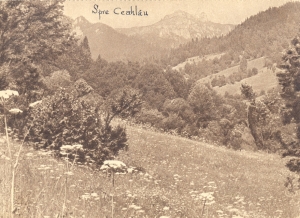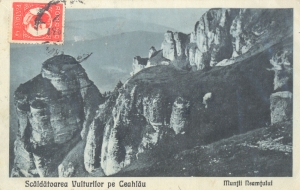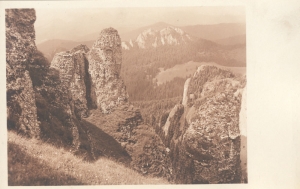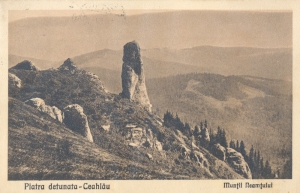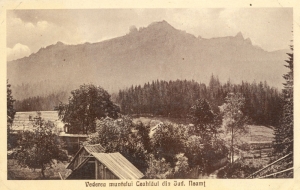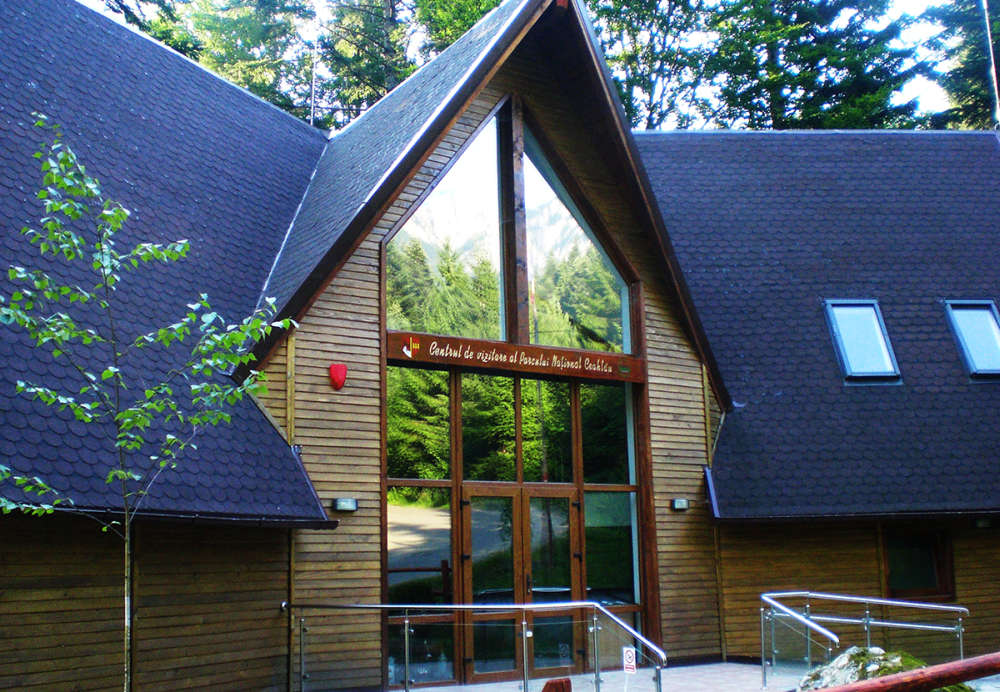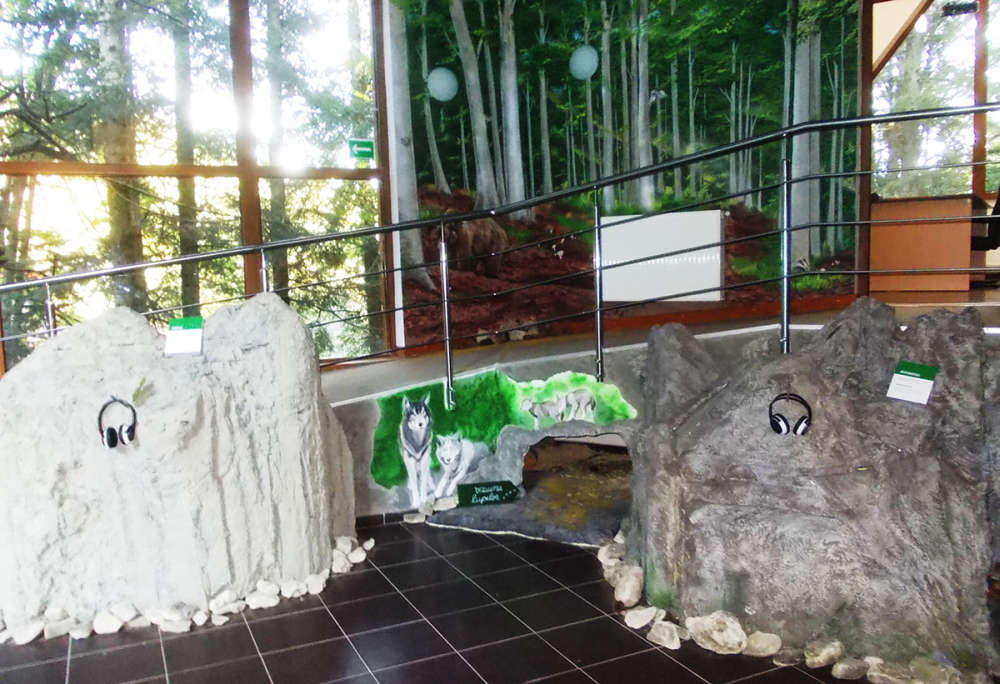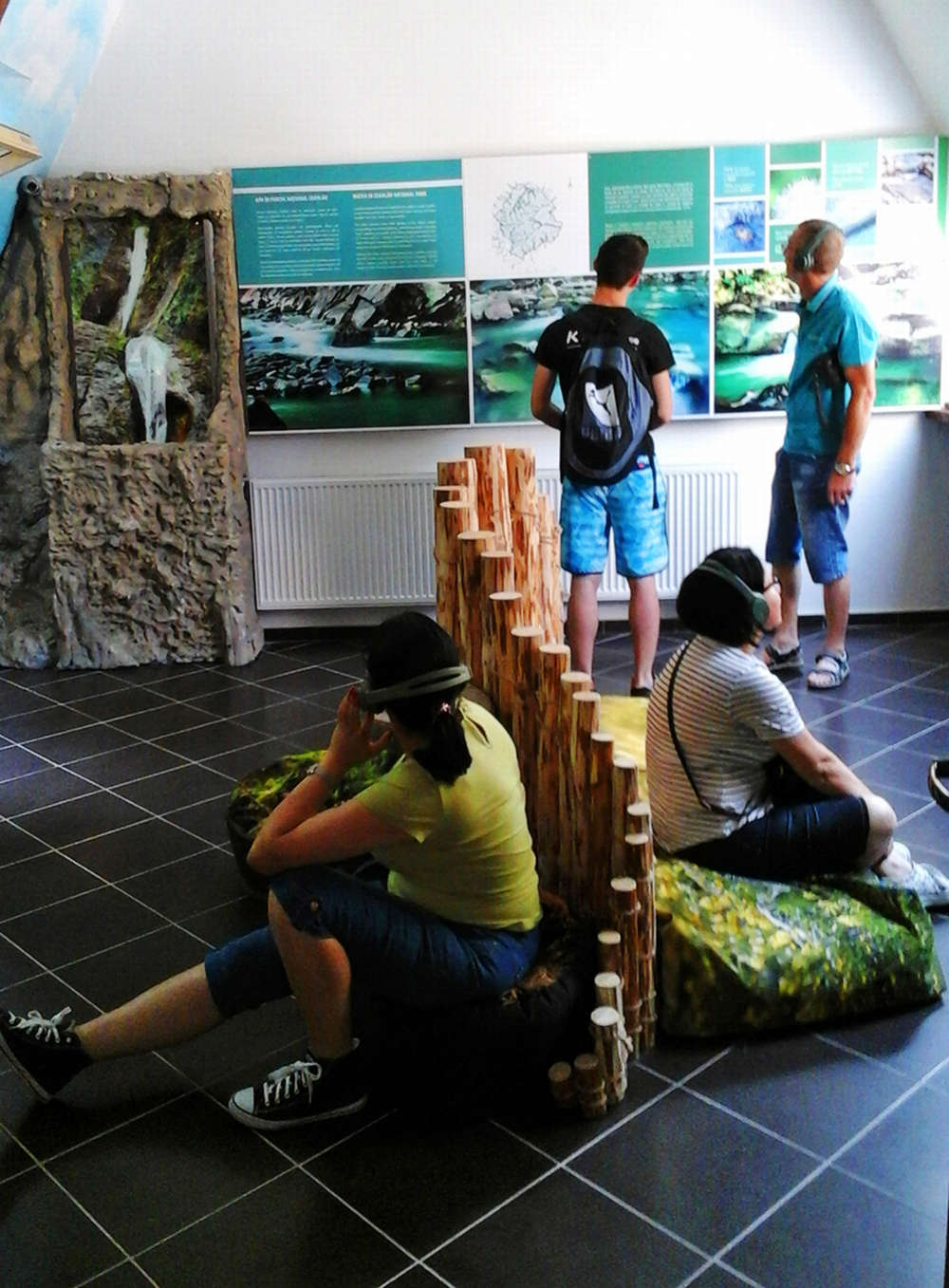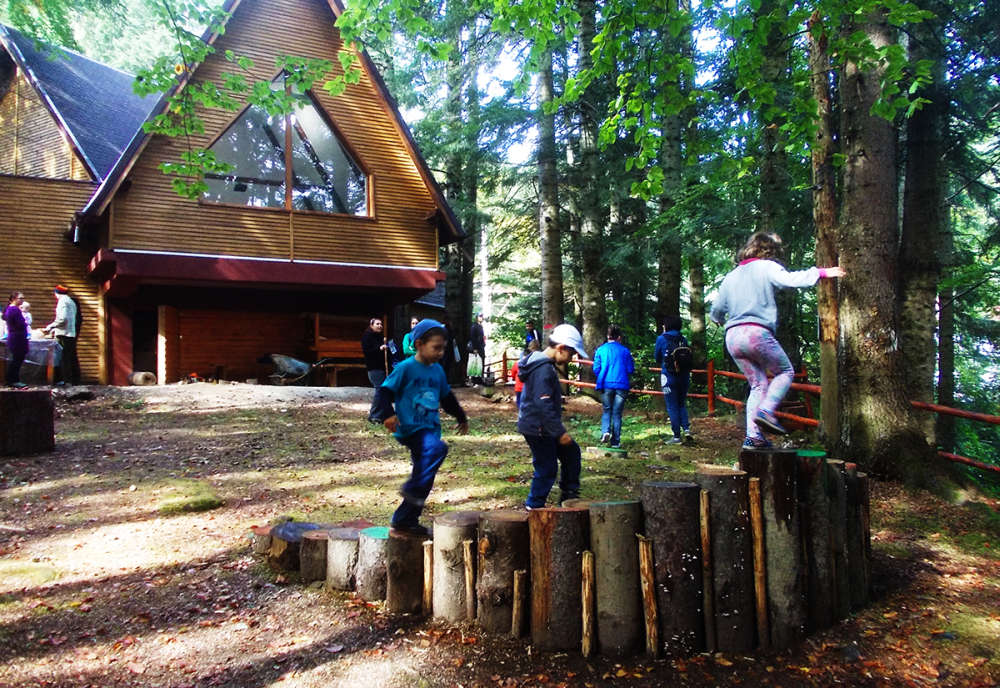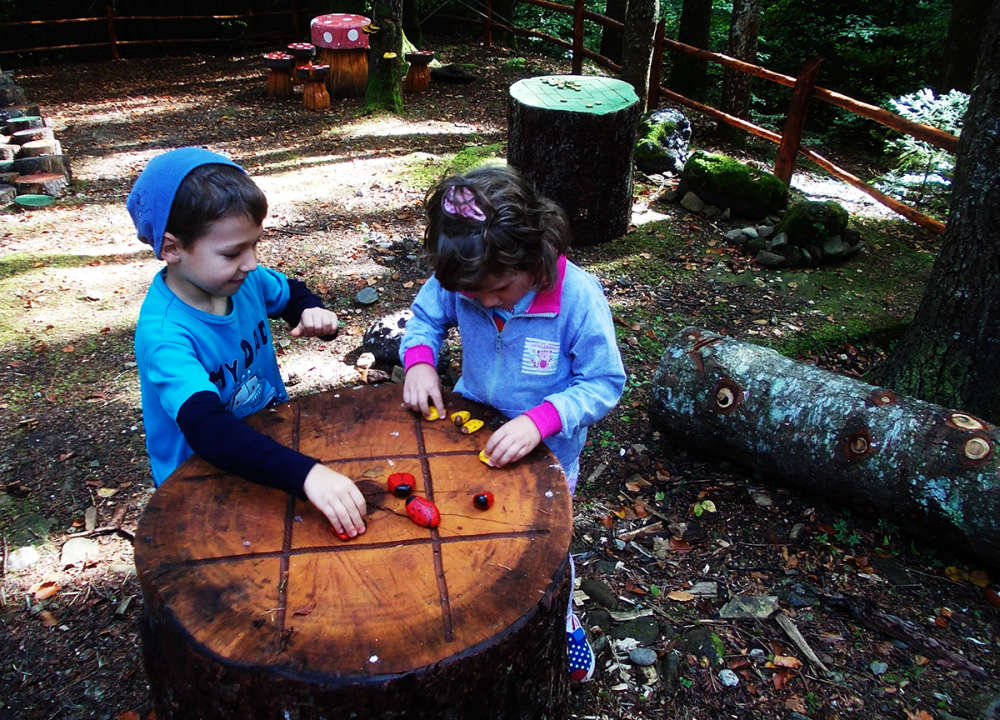Foreword
A world populated by fantastical or real creatures and historical characters is revealed, expressing creativity, measure and good taste of the Highlander from the foot of Ceahlău from which Vasile Alecsandri found the beautiful ballads of “Mioriţa”, “Şalgăi”, “Miului” or “The thief and the lady” and “Scattered Church.” The giants, ogres, demons, fairies, Noureanu, Stone-Smasher, Crooking-Wood, God and Saint Peter, witches, monks, boyars, peasants, outlaws, but also Alexander the Good, Dragos Vodă or Stephen the Great and Vasile Lupu are not missing from their stories.
In this small anthology we chose some of the legends of the rocks on top of the mountain, that we will enrich them with information boards that will contain the texts of legends in Romanian and English and suggestive photos and even old postcards, some since the beginning of XX-th century. It will be created a thematic path, “Rocks with legends”, this anthology being complementary. We invite you to read this book, but furthermore, to walk on the paths of Ceahlău and discover the rocks which, with their strange shapes, gave rise to the legends of Ceahlău.
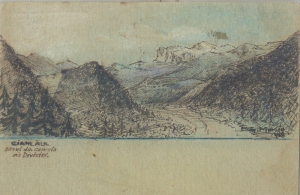
Genesis
Toaca (The Semantron)
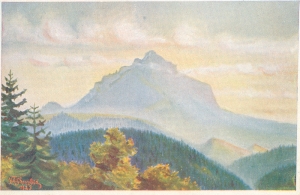
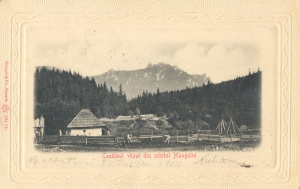
The legend of Panaghia
It is said that, Panaghia was a girl from Răpciuni village, which grew up near the old Palace of Princes, being one of the maids of Maria Cantacuzino. But her mistress sees her husband killed by greedy and heartless ruler Duca, and the son in law, son of Brâncoveanu, loses his head on the stump from Edikule. Out of the dark shadow of Palace of Princes the girl shone in the sun. The lads from villages were not seeking other girls at Sunday round dance anymore. Moreover, they were not ceasing with the care they were giving her. They were leaving scythe, ax and sawmill and were gathering around the girl. The Community Council, those good and old people, were witnessing helpless to their sons’ madness. They went to their leader and asked him to save them from Panaghia’s charms to have peace in the village. Panaghia was carried on Ceahlău’s plateau, where mother Nazaria died squeezed of vigor, near the haughty rocks where kites and chamois have sheltered. She wanted to take her own life. She heard about a hermit called Gideon, but she found at his shelter near Stone of Altar only the bones bleached by time.
She climbed Toaca thinking to find her peace in the abysses below. When, suddenly, through the mists, the Sun appeared… Panaghia saw him and stood spellbound watching him. The Sun had stopped to look at the beautiful from the top of the rock. And he was loosing whole hours from its way to twilight. The next day, Panaghia climbs again on top, on Toaca.
And the Sun endlessly extend his staying over Ceahlău. But, the Night prayed to God against the Sun that was abducting her darkness. God was protecting those in love, but were entangled those decided since the creation of the world and decided to punish the amorous Sun… The Ceahlău was dressed in black and heavy mists and Panaghia was waiting in vain her beloved to break the gray mists. She wanted to go down to the village, where she saw the light… But at the foot of Toaca felt how her legs are taking roots, how her breast and arms and shoulders are taking the immobility of stone. Only eyes were rising to the Sun, who defeated too late the mists.
It is said that her grieved heart does not stopped beating. And even today the Sun remains more above Ceahlău. And is dressing in sunbeams mantle, sometime, bright as Panaghia, now the most beautiful rock of the mountain.
The Wisent’s wreath
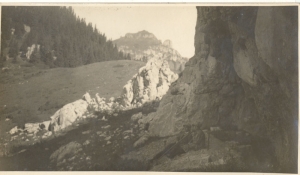
Arrived on the valley of Bistrita, Dragos and his companions reached the Linden’s Stone, and from there went on the valley of Hermitage brook.
Imperceptibly they arrived at a place called “At Stools”, where they halted and prepared to rest, when suddenly a herd of wisents appears. Frightened by seeing the men, the wisents fled disorderly. Only one they were able to hit with an arrow and left to follow it until the “Crippled Foot”, on a ravine which since then was called “Prince’s Ravine”. Coming to light, the wisent went under Toaca and Panaghia, to the ravine. Squeezed of power, followed closely by hunters, the wisent went down among rocky tusks under Flat Stone.
Exhausted, with shivered mane, it passes away in the struggle of death.
The wreath of wild rocks where the wisent from legend has fallen, it is called since then “The Wisent’s Wreath”.
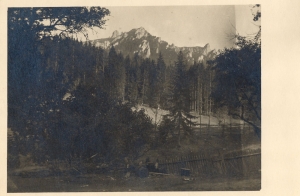
Haystacks of Miron
It is said that here an old shepherd, called Miron, a native of Bicazul Ardelean, was halting with his sheep, choosing the rich pastures beneath the Dacian Table and he was often halting to gaze to Hăşmaş towards Solitary Stone. He liked both those weird and sharp rocks sitting and playing the oat, besides them. The creatures of the forest were listening spellbound. Even the hermit Gideon was descending from his shelter, near Altar Stone, to listen his peerless verse.
The shepherds and hermits, chamois, greater spotted eagles, called “ceahlăi”, the rocks and peaks knew him there. They were hearing his oat. They all were endearing him and he loved them dearly. It is said that he died near his rocks squeezed of vigor. His bones bleached by times were not found and people were saying that they were received by the rocks. His oat was not singing anymore. But sometimes, when the wind strengthens with his heavy breathing among the mountain pines and rocks, it seems that Miron’s oat is heard striking though its stones.
Stănilă and the Weeping Stone
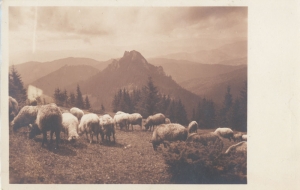
The lad was hired as servant to the Greek tenant Hagi-Paraschiv from Hangu domain of Buhalniţa Monastery and was sent to the sheep, knowing their craft from his father that accompanied him when he was little with the herds on the mountains. He had 20 sheep which joined them to the Greek’s herd. The tenant had three daughters, one more beautiful than other, and the smallest of them was accompanying with her eyes the young shepherd when he came to the court, because he was a very handsome lad, as the story says. And little Stănilă liked the girl, because it could not be otherwise, but he did not dare to raise his eyes to the offspring of the rich Greek. The girl made the first step and the lad replied to an innocent love.
The Greek did not even want to hear about such marriage, but at the crying of the girl in love he replied cunningly. He asked Stănilă to leave and make a fortune, even as much as girl’s dowry and only then he will be worthy to be his son in law. The lad left the court and returned in his small village with his sole fortune, the 20 sheep.
He was often climbing the height by “At Stools” and “Fences Ravine” up to the plateau of Ceahlău. He has put in his head to look for one of the treasures that elders said that were hidden in Ceahlău and begun digging somewhere at the end of the ravine, below the fence of rocks that was stretching up to the slope. He was digging worthy, but there was no sign of treasure. When he was losing hope, he was climbing up to sheep above the fence of rocks and struggle his thoughts to find means of enrichment. But time passed and fortune did not seem to be collected. One day, news came from the village that the Greek has sent his daughter to Iaşi in order to marry a wealthy merchant, a relative of them. Due to helplessness and pain, Stănilă throws himself from the rocks towards the pits that he dug himself. He was crushed by the rocks on the way down and hits the ground breathless.
The old mother, seeing that her son does not return home, although nearly a month had passed, begun to search him on Ceahlău. She found the sheep up on plateau and the scream of bearded vultures showed her where the corpse was. She gathered a pile of bones that begun bleaching and took them up to the Fountain of the Bishop, where she washed them with holy water hallowed by the mountain’s hermits. She buried the bones next to a strange rock, not far from the spring, and put a cross to the head. She never descended to the village, remained with the sheep on the mountain, and rocks and creatures of the Ceahlău, all knew her cry of grieving mother. But after a while, her groan was not heard anymore. Only tears have left that flow from the rock that received her inside. And the old mother still cries today, because from the rock tears are trickling. People have called the rock, which looks like an old woman, the Weeping Stone and the rocks from which her son thrown himself they called the Fence of Stănilă or Stănilele…
Dochia’s Wedding
The eldest of them was a giant which he called Ceahlău and put two large diamonds as eyes that were shining in the moonlight. The craftsman carved him with a knee on the ground and stonecutter’s daughter was climbing easily his knee and then his arms until his shoulders and, on top, on lifeless giant, she liked to gaze the unbounded horizon.
The fame of stonecutter from East reached that country’s prince who came with several of his faithful men to see with his own eyes the wonders raised from stone. The sullen Onu softened when he was praised by high faces which visited him and enjoyed when the prince even asked him to reveal some of the mysteries of the craft. The prince had one more reason to delay: he fell in love with the girl. Among cold stones, the two young have confessed each other the fire of love and the wedding day was fixed for the beginning of August, when God made the mountain more beautiful than ever, dressing it with innumerable flowers, with unparalleled ornaments of white edelweiss and red flowers of Stout’s blood, and the birds by their song make it look like the angels came down the mountain. But, from the North, a spiteful prince wanted to seize this rich country and was seeking for reasons of war: he sent suitors for Dochia’s hand, if not he will pounce at once at the head of his wild hordes, exclaimed messengers. Onu and the prince, Dochia’s destined fiance, prepared for fighting and came out to confront the wrath. Dochia remained in stonemasonry and often climb on the shoulders of gentle Ceahlău to look away. Suddenly, she saw that the fire is coming to the corner of the horizon and understood that ours are overwhelmed. Following her father’s advice, with heavy pain she immediately slaughters the seven white yeanlings which always were accompanying her and sprinkle their blood on the stouts of stone, which thus came to life. The giants departed with heavy walk that was shaking the ground, sweeping the enemies with small eyes and black hearts from the North. Dochia, on giant Ceahlău’s shoulders, her sole remaining companion, saw a long line of lights approaching. She has no more yeanlings to slaughter and then she cuts her wrists so as through her blood to come to life. The numbed Ceahlău raised his knee from dust and wanted to leave, but he saw that those who came in long line, with white clothes, food and drink chosen as for wedding were the prince, Onu and the leaders of victorious army. But Dochia did not managed to tie her wrists and blood drained and with it the life of beautiful and delicate body. She crashed among her beloved yeanlings.
The old Ceahlău begun to cry and along with him Onu and the prince, and from his clear eyes of diamond heavy streams of tears have trickled. All around him have petrified covered with tears: the prince, Onu, the soldiers, Dochia and the yeanlings.
At his feet, Dochia has turned to stone and her beautiful face looked westward for several centuries until a heavy broken piece of snow has brought from the top of the mountain rocks and whole uprooted trees which cut the girl’s petrified image. The yeanlings surround her even today: are some small stones that began to catch moss and listen quietly the murmur of White Spring. Ceahlău remained to guard them and from his eyes were still trickling tears. Elders were saying that from an eye flows today the Cold Spring, known by us as Bishop Fountain and from the other the spring called “the spring of Voda”. A villager said that even today, at the beginning of August, when Dochia had to be bride, there are some who climbs the mountains with food and drink and white clothes to remember and honor, this way, an unfulfilled wedding. Elders say that the story is as old as Ceahlău…
Eagles’ Bathingplace
No one knew about the girl, and the prince put his servants to find her, he even has promised five coins of gold for the one who could give an explanation. It was found an old woman, a Devil’s beldam, which showed that the girl could be at the sheepfold of Lisandru, at Eagles’ Bathingplace. Armed servants have left to catch him between spears and abyss. Lisandru ran up with his face up towards the rocks, but did not succeed to extinguish the fire. They watched and lured him with promises of gold and nobility, but the young man asked for blessing of marriage.
But the boyar not even wanted to hear… The girl and the lad headed to the edge of the precipice and have thrown themselves into the abyss below. They have crushed of sharp edges of the rocks… Some of the elders do not believe that this would have happened. They are saying that Lisandru only pretended that he threw himself, but he jumped on a path, known by himself only, and escaped the encirclement. He got lost in the world with the girl he loved and who had rejected the comfort living among the wealthy. They lived with fewer possessions, but much love and happiness…
Budu and Ana
There is no wonder that even the ruler’s daughter, Ana, begun to endear the young lad. Bewitched by the beauty and virtue of the girl, Budu replied her with his love. They have sworn each other eternal faith and not even death do them part. They began preparations for the wedding, the ruler giving them his fatherly blessing. At the eastern borders fires were lit. They were announcing Tatars danger that on small and fast horses, were robbing, enthralling and burning the poor country of Moldavia. Budu departed in front of Moldavian horsemen to confront the lawless people with small eyes and black hearts. An arrow released from the bow of a Nogai find its way through the Budu’s coat of mail, ragged by so many clashes, and Ana finds out with pain about the unfortunate end of her fiance. She was not able to endure his death and asked for the help of black spirits, to bring her lover beyond death. In one dark night, called by a witch spells, Budu came on a winged white horse, took Ana and headed to the plateau of Ceahlău where he spent childhood. But dawn shatters the spells and the first cocks’ singing finds them both over the mountain. A terrible thunder was heard and, from the skies, Budu and Anna fell down hard near Rooster’s Ridge. The Sun founds the two young in rock mantle, two twin stones, one larger, Budu, and another smaller besides, Princess Ana. Elders from Răpciuni were saying that when the full moon appears, if the shadow of the Tower of Budu descends over Princes’ Palace, that found by time among ruins is transformed in ghost, as Budu, the one called beyond death.
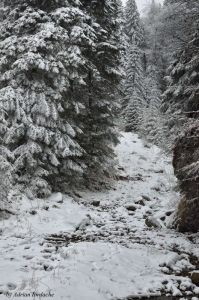
The legend of Dochia
Fearless Decebal wanted to flee to the mountains and gather other armies to continue the fight. But Romans found out and started tracking. One by one Dacians fell. Seeing that there is no escape, Decebal summoned his daughter and ordered her to renounce at royal clothes. To get dressed in shepherdess clothes and run at night to the sun-rise, always to keep the forest path until will reach the mountain Cogheon, the halidom of the god Zamolxes. The emperor was very angry hearing that Decebal’s daughter has escaped from his hands. He gave a tremendous order to a centurion to turn inside out the country, and not to come back without Dochia. So it was made that the Dacian king’s daughter ran through the forest, like a frightened hind, and behind her, like a pack of wolves, the Romans were approaching. Thus, Dochia reached the foot of the mountain Cogheon. She began to climb slowly towards the peaks shrouded in mist. The forest was rarifying, trees were increasingly smaller, crouched by wind power. Ragged rocks were ready to fall over those courageous that wanted to get into the halidom of Zamolxes. Among mist the eagles were coming and disappearing in wide turns and the wind seemed to be a cold death blow.
Step by step, pursuers were following Dochia. Dochia looked up at the gray and dead rocks, at the sad mists and bloodthirsty vultures.
– I better stay forever with you, to be one with the cold rock, but only to get rid of the shame of slavery, demanded Dochia. You, Zamolxes, god of sky and lightning, take me as a small pebble at the foundation of your altar and I will never regret that I have lost my life!
A terrible thunder was heard from the peaks hidden in clouds. The centurion stretched out his hands to embrace Dochia when thunder was repeated. It was clearly heard how up there rocks split by lightning were rolling. Boulders, flagstones were flowing downhill, tree trunks were falling, and trees’ trunks were creepy crackling and so the broken bones of the Romans. After a few moments, remained no living beings. The storm has passed. Greedy vultures were circling over the bloody bodies. Only Dochia was not seen anywhere, except if she was transformed in that lonely, white rock that bears her name.
Thundered Stones
Along with a handful of faithful subjects headed to the Mount of Pion and buried his treasure somewhere near Altar Stone and Blunt Stone of Gideon, at the foot of a large round rock. He entrusted to guard the treasure an old hermit who was living in loneliness and immaculacy on the top of the mountain. Sometimes, when his powers were helping him, he was climbing the highest peak of Ceahlău, where he had a semantron of hardwood of yew, calling for praying all hermits of the mountain. At the foot of the rock, where the unfortunate king buried all his savings, he raised a cross of fir wood to cast out evil spirits. But, the hermit died. Also, the king and the few who knew the secret of the treasure have died. The cross rotted and flowed through the rocks… This is what Satan was expecting. He started diligently to dig among rocks, but in vain. Furious, thousands of lightning has released upon the round and shiny rock. The rock was thundered. The gold has melted and flowed into the depths of the earth. There remained nothing but some rocks that seem like once were one. They are the Thundered Stones, ugly and jagged as Satan’s grin…
The Stone with Water
Sunday, he came out dressed in rich vestments at the round dance, and in his girdle golden coins were jingling, but the girls ran from him as from the Devil. And so passed one, two, three Sundays and Budihău (Paunchy), as people nicknamed him, realized that he can’t have a beautiful wife unless he will buy one. He passed the mountains to the Country of Dorna and found a poor family where the father, a lumberjack, was not succeeding to feed the many mouths which were demanding food. With the ax and saw he was earning only for the daily living. He was dreaming to have a car and two oxen. Budihău found out at the pub about that man’s need and that he had a daughter, the eldest of those eight children, and the girl was beautiful and diligent. At a glass of brandy, the poor lumberjack consented to give his daughter for a car and two oxen, to which Budihău added a cow being delighted that he will get such a beautiful girl. Măriuţa yielded at her father’s and mother’s entreaties, hoping that her younger brothers will be better and she will not be too bad. She passed the mountains to a new household and family.
But, although surrounded by all she has dreamed of, was not happy. She didn’t love her husband and didn’t give him children. The ugly and paunchy was guarding her as his own eyes and was keeping her always beside him, and if she remained alone, a dog trained by him was taught to jump on anyone who approached his wife. One day, however, when she was picking up blueberries on Ceahlău’s plateau, met a young shepherd, who had lost a sheep in a ravine near Thundered Stones. We don’t know if love is really a thing with sense or the dog was foolish, but those two have loved each other for two summers under the understanding sight of the dog that was guarding them above the vault where the young lovers sheltered.
But, in the third summer Budihău found out. He hired on big money four thugs who had hit the young lad with hatchets and rolled him into the abyss that stretches deep under the rock that had witnessed so many moments of love. The girl came, waiting in vain her lover, crushed by heavy thoughts. But, in one day the dog discovered the corpse of the young shepherd. The girl wanted to throw herself in abysses where her lover found death, but in pain fell unconscious. The dog was watching her, lurking her weak breath, when, suddenly, felt the thugs closing which were coming to catch the girl and take her back to her husband decided by the parents. The faithful dog howled loudly and woke her mistress. Seeing the murderers of her beloved approaching the rock, she has started to climb the high and right rock, which seemed impossible to climb. And his faithful dog followed her, but fell into the abyss. Budihău’s thugs looked stunned the girl who reached the top of the rock but they did not have the guts to climb it. They have waited for three days, but she did not come down.
It is said that for three weeks her wail was heard, on peaks, on the rocks. Suddenly, the wail ceased. From the rock’s top began to drip drops of crystal clear water. They were the very tears of the girl.
People came to see the barren stone from which water is now flowing. And they realized that is the dew of girl’s eyes and called it the Stone with Water. Those who spend the night nearby are hearing in night a heavy cry. It is of the girl that’s weeping her unfortunate love.
Conclusion
Vasile Alecsandri, in his notes, was evoking that he found out stories and ballads from bagpipers, hunters, monks, guides in “his walking in the mountains”. So, Alecu Russo, who found a superb “Mioriţa” at the sheepfold of the shepherd Udrea from Ceahlău, or Thadeus Hâjdeu who was picking up from “Muntenia Neamţului” a variant of Dochia’s legend before Gheorghe Asachi, or Eminescu that found at Princes Palace the legend of Budu which will be a source of inspiration for two of his poems or Alexandre Dumas who wrote “The ghost of the Carpathians”. The legends appeared in the first Romanian “yearbooks” and “calendars” from the first half of the XIX-th century, and then in the magazines from the end of the century at Fălticeni, Broşteni or Piatra Neamţ, being taken over and enriched by Mihail Sadoveanu, Calistrat Hogaş, Constantin Matasă, Ioan Găvănescul and then Elena Matasă and Gheorghe Iacomi. Our turn has come and still there are among us elders in the villages that know legends and each generation of students involved in collecting folklore still found some story that deserves to be better known.
Ceahlău is the Romanian mountain with the most stories, and we all understood the point of such undertaking: the shaping of the itineraries of the spirit for those who come here to us. And Ceahlău deserves to be known its stories, by Romanians or foreigners, young or old. Ceahlău awaits you, discover it with all its beautiful things and, believe us, there are not few…
(Legends collected and presented by Daniel Dieaconu)

